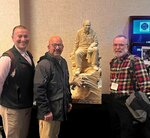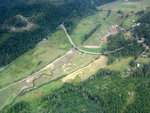

Beginning in the early 1980s, the acrimony over treaty-right fishing began to diminish. The state’s approach to salmon management finally recognized the need to make peace with federal law and with the tribes. A tentative willingness to cooperate evolved into the salmon co-management regime we have today.
One key part of this evolution occurred in 1984-85. Tribal leaders and representatives of the Washington Department of Fisheries crafted the Puget Sound Management Plan (PSMP), filed in 1985 as ordered by the U.S. vs. Washington court. The principles laid out in this plan, with subsequent modifications, still guide salmon management today.
Implementing it required structural changes in state agencies. The state legislature merged the fisheries and game departments into the Department of Fish and Wildlife. This facilitated data sharing and joint analysis to determine how many fish could be harvested, and how many needed to return to their rivers and reproduce to sustain and improve fish species.
Another important post-Boldt event occurred in 1999, when a number of salmon species and stocks, including Puget Sound Chinook, were listed by the National Marine Fisheries Service as endangered under the Endangered Species Act (ESA). Puget Sound Steelhead was added to the ESA listing in 2004. These listings changed how salmon harvests were managed since harvesting an ESA-listed species can only occur when the goals were being met for the number of fish that returned to reproduce. (Here’s a link that provides more details.)
By 2024 it was easy to see that the Boldt decision benefitted everyone who fishes salmon, and the salmon themselves. Judge Boldt held that treaty rights included the tribes’ right to manage their own fisheries. As a result, all the treaty-right tribes have developed their own natural resources departments. As fish stocks were ESA-listed, the tribes had the staff and expertise to step in to develop and implement recovery plans.
When the Washington State Legislature authorized the development of salmon recovery plans, tribal expertise was required. Judge Boldt had recognized the importance of planning watershed by watershed. This was a new way of thinking for state agencies, which had focused on their own invented “regions.”
For the tribes, a river and its watershed were commonly a definition of “home,” and central to a tribe’s unique identity. For the Nisqually watershed, the Nisqually Indian Tribe was selected by the state as the lead agency for developing and implementing salmon recovery plans in its home territory.
Salmon recovery plans have been oriented toward restoration, enhancement, and protection of critical salmon habitat. Many tribes have taken leading roles. One of the most famous is the removal of two dams that blocked salmon from miles of habitat in the Elwha River, which originates in the Olympic National Park and flows north through Clallam County on the Olympic Peninsula. It opened the upper reaches of the river to salmon for the first time in over 100 years and has benefited an entire ecosystem.
Succeeding in salmon habitat projects requires good partnerships. That was true on the Elwha, and here in the Nisqually watershed. The U.S. Fish and Wildlife Service and the Tribe, along with many partners, have added some thousand acres of estuarine habitat to the delta. This required removing 100-year-old dikes that had eliminated estuarine habitat to accommodate a farm. That estuarine habitat now provides space for young salmon to feed and grow, and to make the transition from freshwater to saltwater. This is essential to their success when they swim out into Puget Sound and the Pacific Ocean.
Upstream, the Nisqually Tribe and its partners have placed nearly 80% of the Nisqually River’s shoreline miles into a protected status. Protecting the forested habitat along streams is vital to maintaining the cool water salmon need and supports long-term habitat conservation. The Tribe maintains its own tree-planting crew and, along with its partners and volunteers, has, over the years, planted more than 350,000 trees in the Nisqually watershed.
A third important salmon recovery project is occurring along Ohop Creek, a major salmon tributary of the Nisqually River near Eatonville. Originally, this stream meandered across its flood plain and existed as a salmon-friendly forest stream corridor. Then, nearly a century ago, to support agriculture, this stream was ditched and straightened to improve drainage as forests were converted to farm fields. Most of the agricultural operations have closed and, in order to improve stream flow and habitat function, the stream has been re-meandered to restore its original, fish-friendly course.
Another very important post-Boldt event was the signing of the Centennial Accord in 1989. Governor Booth Gardner recognized that as the state celebrated its 100th year of statehood, and just 15 years after the Boldt decision, the citizens of Washington’s 26 Indian tribes still felt the sting of anti-Indian feelings both in the public and in the ranks of some state agencies and employees.
Therefore, in his series of Centennial proclamations, Governor Gardner issued one recognizing the state’s tribes and their sovereignty. Further, he directed his staff to work with tribal leaders to negotiate an accord that, when signed on August 4, 1989, pledged mutual respect and a commitment to work together cooperatively to address issues of mutual concern. It also created an Office of Indian Affairs within the governor’s office.
Since that date, the state and tribes hold an annual summit to review the relationship and discuss areas of concern. Salmon fishing is always on the agenda, but often there are other pressing issues. One important early one was the development of Indian gaming.
In 1988, in the face of pressure from tribes to establish gaming as a form of tribal enterprise, Congress enacted the Indian Gaming Regulatory Act. It established policies concerning gaming, including that states had to approve the form and location of gaming developed by tribes and, using the framework of the Centennial Accord, these agreements were negotiated and approved.
Why include Indian gaming in an account of the Boldt decision? Because the decision reinforced and strengthened Indian tribal sovereignty and that led, among other things, to Indian gaming that in Washington has been enormously successful, producing thousands of jobs and important revenue for tribes and Indian communities. Also, tribal gaming operations distribute a portion of their income to local non-profits and governments. In 2023, the Nisqually Tribe distributed $1.5 million.
Tribes now are very important economic engines for Washington communities. In Thurston County, the Nisqually Indian Tribe employs over 1,000 people and has an annual payroll exceeding $60 million. These are all local people who spend their pay right here in Thurston County. As our local economy thrives, so do we all.
In summary, we now have talented salmon managers at every level, federal, state and at each tribe. Salmon management in the post-Boldt world is more skilled and more coordinated than ever before.
And yet, for salmon the news has not been good. In the past 10 years, total salmon harvests in the state’s various fisheries have declined by 80%. State and tribal salmon management are addressing the declining salmon stocks, but every year there is continued degradation of salmon habitat. Maybe it’s not always obvious, but population growth, commercial development, and more roads and runoff pollution (and climate change, of course) lead to declining marine productivity.
In 1987, the Nisqually River Tribal fishery was open for 105 days; in recent years the amount of fishing has declined to as few as eight days. It is simply wrong to think that the salmon difficulties can be solved only by harvest adjustments; we need to address the many environmental problems, large and small, that hinder salmon productivity.
And yet, because of tribal management authority resulting from the Boldt decision, there is reason to be hopeful. The Pacific Northwest Tribes recently held a two-day event commemorating the 50th Anniversary of the Boldt Decision. At the end of the event, the Nisqually Tribal Council gifted carved canoe paddles to recognize various vital contributions. Among those called forward were Craig Bill of the Governor’s Office of Indian Affairs and Kelly Susewind, the Director of the Washington Department of Fish and Wildlife.
Some wondered why the state was being recognized. As Nisqually Tribal Chair Willie Frank III explained, “We’re all in the same canoe. We’re working together to provide for our salmon, both now and into the future.” This is the most important result of the Boldt Decision, creating the legal framework where the State of Washington and the treaty-right fishing tribes work together as co-managers to protect and enhance the state’s greatest natural legacy, our salmon.
There is hope, but there is also much more work to do, and it is urgent.
George Walter, environmental program manager at the Nisqually Indian Tribe’s natural resources department, has worked for 45+ years in various elements of fisheries for the Tribe. He may be reached at george@theJOLTnews.com
3 comments on this item Please log in to comment by clicking here
wildnature
Deepest thanks to the Nisqually Indian Tribe, the Nisqually River Council and all the rest of the array of people who have made this world, one we want to live in. Thank God Billy Frank and other's took that risk 50 years ago getting arrested, a lot, and thanks to Bolt and his decision when Salmon were hanging in the balance. God speed for the remaining work that needs to be done. I'm so grateful to get to live here.
Jean Shaffer
Tuesday, February 27 Report this
Boatyarddog
Nature Should Never Hang in a Balance.
Restoration is Paramount to Sucessful Ecosystems.
Let us Restore... not just Remeadiate our Forests and Bay.
Example: Remove Sediments to a proper Landfill in Budd Bay.
Let us NOT just dig a coffer and bury those toxic sediments in a Concrete Containment vessel.
Back into Budd inlet to rot away and become a problem for Our Future Residents.
Tuesday, February 27 Report this
Boatyarddog
My Meaning is to Remove those
Sediments Off Site ...Out of The Waters.
Tuesday, February 27 Report this